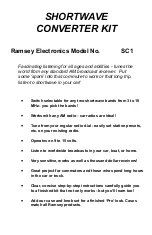
19
ELECTRICAL HAZARDS
• The generator covered by this manual produces dangerous
electrical voltages that can cause fatal electrical shock. Avoid
contact with bare wires, terminals, connections, etc., while the
unit is running. Ensure all appropriate covers, guards, and bar-
riers are in place before operating the generator. If work must
be done around an operating unit, stand on an insulated, dry
surface to reduce shock hazard.
• Do not handle any kind of electrical device while stand-
ing in water, while barefoot, or while hands or feet are wet.
DANGEROUS ELECTRICAL SHOCK MAY RESULT.
• During installation onto the vehicle, properly ground (bond)
the generator either by solid mounting to the vehicle frame or
chassis, or by means of an approved bonding conductor. DO
NOT connect the bonding conductor to any generator part that
might be removed or disassembled during routine maintenance.
If the grounding conductor must be replaced, use only a flexible
conductor that is of No. 8 American Wire Gauge (AWG) copper
wire minimum.
• If the vehicle electrical circuits can be powered by any other
source of electricity (such as, a “dockside” power receptacle),
there must be no possibility of connecting the different power
sources to the vehicle’s circuits at the same time. The dock-
side (utility) power source must be positively isolated from the
vehicle’s circuits whenever the generator is operating. Failure
to isolate the vehicle’s circuits from the dockside power sup-
ply when the generator is running may result in damage to the
generator or in serious injury or death to dockside (utility) power
workers due to backfeed of electrical energy.
• In case of an accident caused by electric shock, immediately
shut down the source of electrical power. If this is not possi-
ble, attempt to free the victim from the live conductor. AVOID
DIRECT CONTACT WITH THE VICTIM. Use a nonconducting
implement, such as, a rope or board, to free the victim from
the live conductor. If the victim is unconscious, apply first
aid, and get immediate medical help.
• Never wear jewelry when working on this equipment. Jewelry
can conduct electricity, resulting in electric shock, or may get
caught in moving components, causing injury.
FIRE HAZARDS
• For fire safety, the generator must be installed and maintained
properly. Installation always must comply with applicable
codes, standards, laws, and regulations. Adhere strictly
to local, state and national electrical and building codes.
Comply with regulations the Occupational Safety and Health
Administration (OSHA) has established. Also, ensure that the
generator is installed in accordance with the manufacturer’s
instructions and recommendations. Following proper installa-
tion, do nothing that might alter a safe installation and render
the unit in noncompliance with the aforementioned codes,
standards, laws, and regulations.
• Keep a fire extinguisher in the vehicle at all times. Extinguishers
rated “ABC” by the National Fire Protection Association are
appropriate for use on the recreational vehicle generator electrical
system. Keep the extinguisher properly charged, and be familiar
with its use. If there are any questions pertaining to fire extin-
guishers, consult the local fire department.
EXPLOSION HAZARDS
• Do not smoke around the generator. Wipe up any fuel or oil spills
immediately. Ensure that no combustible materials are left in the
generator compartment, or on or near the generator, as FIRE or
EXPLOSION may result. Keep the area surrounding the generator
clean and free from debris.
• All fuel types are potentially FLAMMABLE and/or EXPLOSIVE and
should be handled with care. Comply with all laws regulating the
storage and handling of fuels.
• Fuel supply lines must be properly installed, purged and leak-
tested according to applicable fuel-gas codes, before placing
this equipment into service. There must be no possibility of fuel
vapors entering the vehicle interior.
• It is required that an approved, flexible, nonconductive fuel line
between the generator fuel connection point and the rigid fuel
lines be installed.
CALIFORNIA PROPOSITION 65 WARNING
Engine exhaust and some of its constituents are known
to the State of California to cause cancer, birth defects
and other reproductive harm.
CALIFORNIA PROPOSITION 65 WARNING
This product contains or emits chemicals known to the
State of California to cause cancer, birth defects and
other reproductive harm.
Safety Rules
Summary of Contents for quietpact 85d
Page 23: ...21 Figure 1 2 Major Features and Dimensions Drawing 0G6806 A General Information ...
Page 40: ...38 Electrical Data Schematic 120 240 VAC Output Drawing No 0G7332 C ...
Page 41: ...39 Schematic 120 240 VAC Output Drawing No 0G7332 C Electrical Data ...
Page 42: ...40 Electrical Data Schematic 120 240 Dual Voltage Drawing No 0G7333 D ...
Page 43: ...41 Schematic 120 240 Dual Voltage Drawing No 0G7333 D Electrical Data ...
Page 44: ...42 Electrical Data Schematic 120 240 Dual Voltage Drawing No 0G7333 D ...
Page 45: ...43 Schematic 120 240 Dual Voltage Drawing No 0G7333 D Electrical Data ...
Page 46: ...44 Exploded Views Parts Lists Engine Alternator Starter Assy Drawing No 0G7350 B ...
Page 48: ...46 Exploded Views Parts Lists Enclosure Drawing No 0G7351 B ...
Page 50: ...48 Exploded Views Parts Lists Cooling System Drawing No 0G7352 B ...
Page 52: ...50 Exploded Views Parts Lists Fuel Electrical Systems Drawing No 0G7355 A ...
Page 54: ...52 Exploded Views Parts Lists Customer Controls Assy Drawing No 0G7356 B ...
Page 73: ......
Page 75: ......
Page 77: ......
Page 79: ......
Page 81: ......
Page 83: ......
Page 85: ......
Page 87: ......
Page 89: ......
Page 91: ......
Page 93: ......
Page 95: ......
Page 97: ......
Page 99: ......
Page 101: ......
Page 103: ......
Page 105: ......
Page 107: ......
Page 108: ......
Page 109: ......
Page 110: ......
Page 111: ......
Page 112: ......
















































